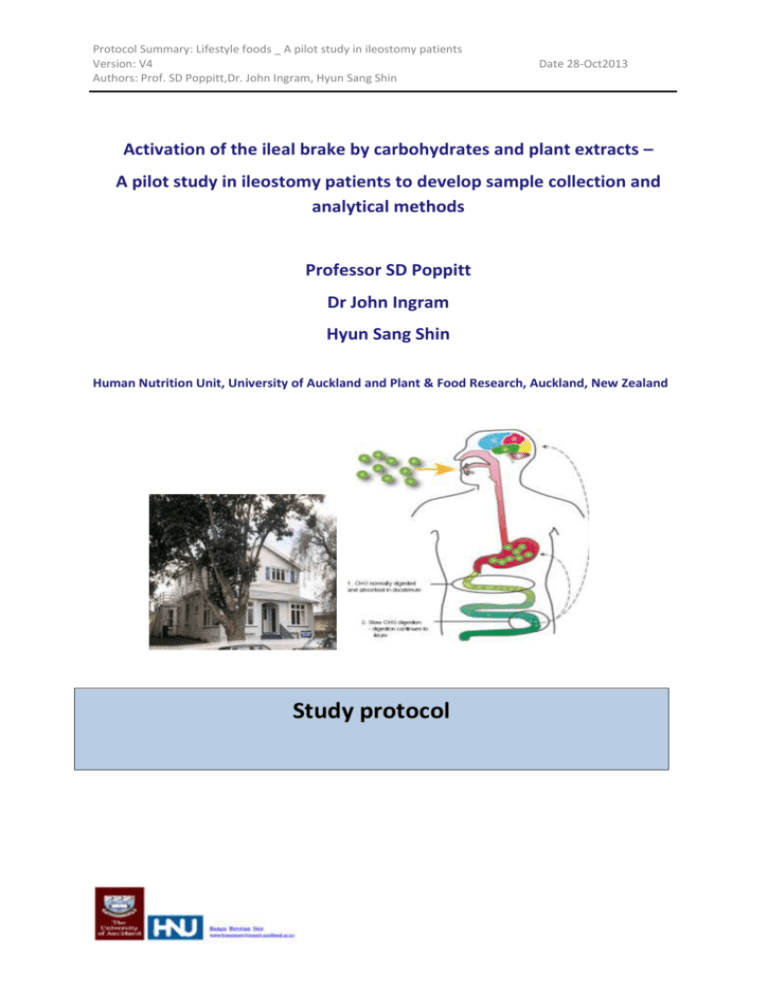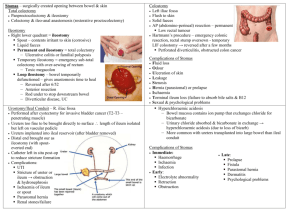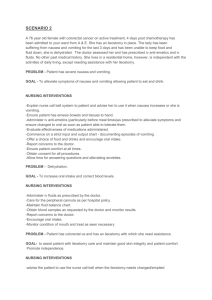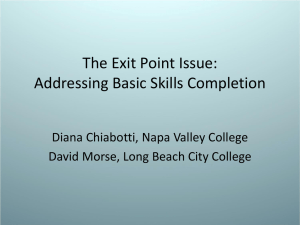Study protocol
advertisement

Protocol Summary: Lifestyle foods _ A pilot study in ileostomy patients Version: V4 Authors: Prof. SD Poppitt,Dr. John Ingram, Hyun Sang Shin Date 28-Oct2013 Activation of the ileal brake by carbohydrates and plant extracts – A pilot study in ileostomy patients to develop sample collection and analytical methods Professor SD Poppitt Dr John Ingram Hyun Sang Shin Human Nutrition Unit, University of Auckland and Plant & Food Research, Auckland, New Zealand Study protocol Protocol Summary: Lifestyle foods _ A pilot study in ileostomy patients Version: V4 Authors: Prof. SD Poppitt,Dr. John Ingram, Hyun Sang Shin Date 28-Oct2013 1. PRINCIPAL INVESTIGATORS PROFESSOR SD POPPITT PHD Director, Human Nutrition Unit (HNU) School of Biological Sciences & Institute for Innovation in Biotechnology University of Auckland s.poppitt@auckland.ac.nz DR JOHN INGRAM PHD Scientist The New Zealand Institute for Plant and Food Research Ltd Mt Albert, Auckland JOHN.INGRAM@PLANTANDFOOD.CO.NZ 2. PHD STUDENT HYUN SANG SHIN, MD, MSC POSTGRADUATE RESEARCH STUDENT HUMAN NUTRITION UNIT, UNIVERSITY OF AUCKLAND PLANT & FOOD RESEARCH, AUCKLAND H.SHIN@AUCKLAND.AC.NZ 3. MEDICAL CONSULTANT DR RUSSELL WALMSLEY MBCHB MD Consultant Gastroenterologist Waitemata District Health Board (WDHB) North Shore and Waitakere Hospitals Auckland Protocol Summary: Lifestyle foods _ A pilot study in ileostomy patients Version: V4 Authors: Prof. SD Poppitt,Dr. John Ingram, Hyun Sang Shin Date 28-Oct2013 1. BACKGROUND The gastrointestinal (GI) tract and specifically the most distal part of the small intestine, the ileum, has become a renewed focus of interest for mechanisms targeting appetite suppression. The ‘ileal brake’ is stimulated when energy-containing nutrients are delivered beyond the duodenum and jejunum and into the ileum, and is named for the feedback loop which slows or ‘brakes’ gastric emptying and duodenojejunal motility. More recently it has been hypothesised that the ileal brake also promotes secretion of satiety-enhancing GI peptides and suppresses hunger, and hence in turn places a ’brake’ on food intake. Postprandial delivery of macronutrients to the ileum, other than unavailable carbohydrates (CHO) which bypass absorption in the small intestine en route to fermentation in the large bowel, is an uncommon event and hence this brake mechanism is rarely activated following a meal. Evidence linking the ileal brake to enhanced satiety can be found from a number of studies that have delivered nutrients to the ileum enterally. Early nasoileal (NI) tube feeding studies where lipid emulsions were infused directly into the ileum significantly decreased appetite and food intake (Welch et al., 1985; Welch et al., 1988b; Welch et al., 1988c)(Maljaars et al., 2008, 20009, 2010, 2011, 2012; see review by Shin et al., 2013). There is some preliminary evidence that commercial lipid formulations designed to resist digestion and absorption in the proximal small intestine are transported to the ileum and suppress food intake (Burns et al., 2000, 2001, 2002; Diepvens et al., 2007), although findings from these feeding studies remain mixed (Smit et al., 2011; Chan et al., 2012). Our research group has recently shown that hunger and food intake can be altered acutely by infusion of glucose in to the ileum using an NI tube (Shin et al., unpublished data) suggesting that carbohydrates can also activate the ileal brake mechanism. However, no corresponding evidence exists for ileal brake activation following the ingestion of carbohydrate containing foods. This is likely to be due to the very efficient digestion and absorption of carbohydrates by the proximal SI resulting in minimal glucose availability in the ileum. In order to ensure arrival of CHOs into the distal small intestine (ileum) it is necessary to induce a degree of carbohydrate malabsorption in the proximal small intestine (duodenum and jejunum). This approach has previously been demonstrated using a carbohydrate meal and pharmacological interventions such as the α-glucosidase inhibitor migitol (Lee et al., 2002; Kaku et al., 2012) or a novel glucose transport inhibitor LX4211 (Zambrowicz et al., 2013) where enhanced ratings of satiety and postprandial GLP-1 and PYY concentrations beyond 2 h have been demonstrated, indicating ileal brake activation. A number of natural occurring plant phytochemicals have been demonstrated to posses similar carbohydrate malabsorption potential (Lakshimi et al., 2012), although their ability to trigger ileal brake activation has not as yet been demonstrated in vivo. We have recently identified in vitro, a commercially available grape seed extract (Oxifend® grape seed extract, New Zealand Extracts Ltd) and quercetin possessing the ability to inhibit the activity of starch digestive enzymes and the absorption of glucose by the gut mucosa, respectively. By combining these extracts with a starch based meal we hope to induce enough glucose malabsorption in the proximal SI to activate the ileal brake. However, efficacy of these blockers singularly or in combination has not yet been assessed in a human study population. Protocol Summary: Lifestyle foods _ A pilot study in ileostomy patients Version: V4 Authors: Prof. SD Poppitt,Dr. John Ingram, Hyun Sang Shin Date 28-Oct2013 Plant extract, quercetin and acarbose, pharmaceutical glucose uptake inhibitor for delayed nutrient absorption in the small intestine 1) Oxifend® grape seed extract is produced from the seed of the Sauvignon Blanc grape (Vitis vinifera) by New Zealand Extracts Ltd (Marlborough) using a proprietary water extraction process (see attached certificate of analysis). Grape seed extract (GSE) is used both within New Zealand and overseas as a nutritional supplement high in proanthocyanidins and is designated as generally recognised as safe (GRAS) by the US Food and Drug Administration (USFDA, 2013). GSE has been administered in human clinical studies as capsules or pressed tablets over a range of doses from 300 – 2,000 mg, and shown to be well tolerated, with no adverse side effects reported (Vigna et al., 2003; Clifton et al., 2004; Vogel et al., 2004; Kar et al.2009; Sivaprakasapillai et al., 2009). 2) Quercetin is one of the most abundant flavonoids in fruits and vegetables and the most studied of the flavonoids. Quercetin supplement is widely used as anti-oxidant and antiinflammatory nutrient supplement in New Zealand as well as other countries and has been designated generally recognised as safe (GRAS) by the US Food and Drug Administration since 2010 (USFDA, 2013). Quercetin has been extensively studied in humans over a range of doses from 100 mg – 4 g and no adverse events caused by quercetin has been reported (Manach et al., 2005; Lee et al., 2011). However, quercetin is contraindicated with some antibiotics; it may interact with fluoroquinolones (an antibiotic), as quercetin competitively binds to bacterial DNA gyrase. 3) Acarbose (PrandaseTM, PrecoseTM) is an inhibitor of intestinal α-glucosidase, which results in a decrease in intestinal absorption of starch and currently used as an adjunctive therapy in the management of type 2 diabetes. The typical initial dose in adults is 25-50 mg with each meal (with the first bite), followed by a gradual increase to a maximum of 100 mg three times daily (New Zealand Data Sheet, 2012). Acarbose causes malabsorption of starch and gastrointestinal side effects of flatulence, diarrhoea and abdominal boating are not uncommon. Acarbose is used as a positive control to compare malabsorption of CHO by GSE and quercetin. 1.1 STUDY AIMS The objective of this methods development, pilot study is to assess: Firstly, whether any CHO can be detected in the ileum following a small CHO meal; Secondly, whether the addition of a known pharmaceutical glucose uptake inhibitor (acarbose) results in delivery of CHO to the ileum following a small CHO meal; Thirdly whether (i) encapsulated GSE, a putative starch breakdown inhibitor and (ii) encapsulated quercetin, a putative glucose uptake inhibitor, results in delivery of CHO to the ileum following a small CHO meal; in a group of ileostomy patients in whom it is possible to sample the contents of the ileum directly. Specifically, this pilot study aims to determine whether it is possible to collect and measure dietary glucose which has escaped from digestion and absorption in the duodenum and jejunum, and transited into the ileum This is a small method development pilot study. If it is successful and glucose can be detected in the ileal pouch following delivery of the plant extracts, a well powered trial Protocol Summary: Lifestyle foods _ A pilot study in ileostomy patients Version: V4 Authors: Prof. SD Poppitt,Dr. John Ingram, Hyun Sang Shin Date 28-Oct2013 investigating the effect of oral delivery of CHO to the ileum on appetite control and food intake will be designed. 1.2 HYPOTHESES We hypothesise in this pilot study that available CHO delivered orally can be prevented from absorption in the proximal small intestine and transit down to the distal small intestine or ileum, firstly by the co-ingestion of acarbose, and secondly by the co-ingestion of 2 plantderived compounds GSE and quercetin 2. TRIAL DESIGN This is a pilot study in 7 ileostomy patients, who have undergone prior large bowel resection but are otherwise healthy. Each participant will undertake 1 or more of the 7 treatment arms, below. A 2 MJ CHO (available mono/disaccharide; low resistant starch, RS; low non-starch polysaccharide, NSP) breakfast meal, comprised of 185 g of white toast bread will be given, accompanied by an encapsulated GSE, starch breakdown inhibitor and an encapsulated quercetin, glucose uptake blocker. This is a pilot study in patients with direct access to the ileal contents, to determine whether CHO can be detected within the ileum by sampling GI contents directly from the ileostomy pouch Seven treatment arms will be assessed as follows: 2MJ CHO breakfast, with no encapsulated extracts (negative control) 2MJ CHO breakfast + Acarbose (50 mg), glucose uptake inhibitor (positive control) 2MJ CHO breakfast + GSE (500 mg), low dose 2MJ CHO breakfast + GSE (2000 mg), high dose 2MJ CHO breakfast + Quercetin, (500 mg) low dose 2MJ CHO breakfast + Quercetin, (2000 mg) high dose 2MJ CHO breakfast + GSE (2000 mg)/Quercetin (2000 mg) synergy Figure 1. Study protocol Protocol Summary: Lifestyle foods _ A pilot study in ileostomy patients Version: V4 Authors: Prof. SD Poppitt,Dr. John Ingram, Hyun Sang Shin Date 28-Oct2013 Finish Treatment and (0.5 MJ) 210 min Breakfast S t=-10 S t=15, 30, 45 and 60 St=65,70,75,80,85,90,95,100,105110,115,120,125,130,135,140,145,150,155,160,165, and 170 0850h 0900h 1000h 1100h 1200h Participants will arrive at the Human Nutrition Unit in the fasted state at 08.30am. A 2MJ CHO breakfast immediately followed by the test products in acid-resistant capsule to avoid digestion within the low PH stomach conditions will be consumed at 9am. Participants will be allowed 15 minutes to consume the breakfast, and all components of the meal must be consumed. Ileostomy bag contents, to sample the nutrients that are delivered into the ileum, will be collected at 0, 15, 30, 45, and 60 minutes after the breakfast, and then at 5 minute intervals for the following 2 hours. If gut contents arrive at the ileum prior to 60 minutes then the 5 minute sampling regime will be brought forwards. 2.1 STUDY VISITS AND ASSESSMENTS Screening Visit: Participant information sheet (PIS) provided, study explanation given and written informed consent obtained. Subjects screened for eligibility. Demographics (age, ethnicity) and anthropometry (height, body weight, BMI) Participant to complete medical history Treatment Day: 0830h: Participant arrives 0850h: A baseline sample will be collected 0900h: Participant will be given a standard CHO breakfast immediately followed by the encapsulated test product 0915-1200h: Samples will be repeatedly collected from ileostomy pouch 2.2 RANDOMISATION Protocol Summary: Lifestyle foods _ A pilot study in ileostomy patients Version: V4 Authors: Prof. SD Poppitt,Dr. John Ingram, Hyun Sang Shin Date 28-Oct2013 This is a non-randomised, qualitative, pilot study. Participants may take part in 1 or more treatments. 3. ENCAPULATED GRAPE SEED EXTRACT AND QUERCETIN The GSE and quercetin are delivered orally in an acid-resistant capsule (DRcaps, Capsugel) to protect their breakdown and keep their efficacy beyond the stomach. 4. METHODS 4.1 PARTICIPANTS, MAXIMUM OF N=7 4.2.1 Inclusion criteria patients who have undergone an end ileostomy procedure, where the large bowel has been removed but the small bowel remains healthy and intact procedure conducted more than 12 months previously, and currently stable this may include patients with ulcerative colitis (UC) male or female, aged 20-65 years BMI <40kg/m2 otherwise healthy 4.2.2 Exclusion criteria patients who have undergone loop ileostomy Crohn’s disease; celiac disease; diabetes mellitus (T1DM or T2DM) drug therapies that may alter small bowel transit, including non-steroidal inflammatory drugs (NSAIDs), antibiotics and proton pump inhibitors drug therapies that may interact with Acarbose (PrandaseTM, PrecoseTM) morbid obesity, BMI >40kg/m2 any allergy to grape 4.3 MEASUREMENTS Sample collections from the ileostomy pouch throughout the morning. Blood glucose collected via finger prick will be measured using a hand held glucometer. 4.4 OUTCOME VARIABLES Primary A 10g sample of the ileal pouch contents will be collected into ethanol and kept chilled at 4oC, until batch analyses for glucose are conducted. Secondary Starch, disaccharides (eg. maltose, sucrose) and GSE and quercetin VAS – Nausea, bloating and abdominal cramps Protocol Summary: Lifestyle foods _ A pilot study in ileostomy patients Version: V4 Authors: Prof. SD Poppitt,Dr. John Ingram, Hyun Sang Shin Date 28-Oct2013 Nausea and abdominal cramps throughout the morning will be measured using VAS, on a 100-mm scale. Subjects will rate their feelings in terms of nausea and abdominal cramp, using the scale below Nausea -How nauseated do you feel? -ANCHOR: ‘I do not feel nauseated at all’ vs. ‘I am as nauseated as I have ever been’ VAS: subjective rating = no correct or incorrect answer 100mm line Figure: Example of VAS I am not nauseated at all 5. I am as nauseated as I have ever been STATISTICAL ANALYSES This is a pilot, method development study intended to determine whether glucose or any other CHO breakdown products can be detected at the ileum, following a high CHO meal, under a range of conditions. There will be no formal statistical analysis. 6. INFORMED CONSENT Written informed consent, in compliance with the International Conference on Harmonization (ICH) guidelines, will be obtained from each participant before they are entered into the intervention trial. 7. ADVERSE EVENTS For this protocol, an adverse event (AE) is any untoward medical occurrence (e.g. sign, symptom, disease, syndrome, intercurrent illness, abnormal laboratory finding) that emerges or worsens relative to pre-treatment baseline, during the administration or follow-up periods in a subject who has been administered the study. The untoward medical occurrence may not necessarily have a causal relationship to the administration of the study drug. An AE can therefore be any unfavorable and/or unintended sign (including an abnormal laboratory result), symptom, or disease temporally associated with treatments.. SERIOUS ADVERSE EVENTS (SAE) Protocol Summary: Lifestyle foods _ A pilot study in ileostomy patients Version: V4 Authors: Prof. SD Poppitt,Dr. John Ingram, Hyun Sang Shin Date 28-Oct2013 An adverse event occurring at any dose (including overdose) should be classified as SERIOUS if: It resulted in death (i.e., the AE caused or led to death) It was life-threatening (i.e., the AE placed the subject at immediate risk of death; it does not apply to an AE that hypothetically might have caused death if it were more severe) It required or prolonged in-subject hospitalization (i.e., the AE required at least a 24 h insubject hospitalization or prolonged a hospitalization beyond the expected length of stay. Hospitalizations for elective medical/surgical procedures, scheduled treatments, or routine check-ups are not SAEs by this criterion) EXPEDITED REPORTING: The Investigator will report any fatal or life-threatening adverse event to the HDEC ethics committee within 3 working days. The Investigator will complete an SAE form and immediately sent it to HDEC. The Investigator will report to Dr. Russell Walmseley, consultant gastroenterologist and the reviewing HDEC a report of any unexpected events no later than 10 working days after the Investigator first learns of the event. RECORDING OF ADVERSE EVENTS Adverse events will be collected by observing and interviewing the subject during the study. All adverse events (serious and non-serious) will be recorded on the appropriate CRF/record and will be coded using the MedDRA coding system. The description of each event will include the dates of onset and remission. Additionally, each adverse event will be assessed for severity using the protocol severity grading system (mild, moderate or severe). The SAE report will also contain information on the location, relationship to treatment product, intervention required if any, and the outcome of the event. Protocol Severity Grades: The Investigator will grade all AEs according to and the following protocol severity criteria: Mild - Grade 1: event may be noticeable to subject; does not influence daily activities; usually does not require intervention Moderate - Grade 2: event may be of sufficient severity to make subject uncomfortable; performance of daily activities may be influenced; intervention may be needed Severe - Grade 3: event may cause severe discomfort; usually interferes with daily activities; subject may not be able to continue in the study; treatment or other intervention usually needed Assigning Causality: Using the following criteria, Investigators will also assess whether there is a reasonable possibility that the test product caused or contributed to the AE: A. Definitely Related: There is a clinically plausible time sequence between the onset of the AE and the test product administration and all other potential causes have been ruled out. B. Probably Related: There is a clinically plausible time sequence between the onset of the AE and the test product administration; the AE is unlikely to be caused by the concurrent/underlying illness, other drugs, or procedures Protocol Summary: Lifestyle foods _ A pilot study in ileostomy patients Version: V4 Authors: Prof. SD Poppitt,Dr. John Ingram, Hyun Sang Shin Date 28-Oct2013 C. Possibly Related: There may or may not be a clinically plausible time sequence between the onset of the AE and the test product administration, and product as a cause cannot be ruled out. D. Not related: Another cause of the AE is most plausible; a clinically plausible temporal sequence is inconsistent with the onset of the AE and the test product administration; and/or a causal relationship is considered biologically implausible. 8. CLINICAL TRIAL SITE – THE HUMAN NUTRITION UNIT, UNIVERSITY OF AUCKLAND The clinical trial will be conducted at the University of Auckland Human Nutrition Unit, located at 18 Carrick Place, Mt Eden, Auckland. The HNU is a Uniservices clinical trial facility which undertakes nutrition intervention studies, investigating the relationships between diet and dietary components with enhancement of health and prevention and/or treatment of disease. The Director of the HNU is Professor Sally Poppitt, who also holds a Chair in Human Nutrition within the School of Biological Sciences and Department of Medicine at the University Auckland. Her office is located within the Institute for Innovation in Biotechnology (IIB), hosted by SBS on the UoA City Campus, located at 3a Symonds Street. More information on the HNU can be found on the website and accessed at www.humannutritionunit.auckland.ac.nz 8.1 PREVIOUS CLINICAL STUDIES INCLUDE: Cooper GJS, Young AA, Gamble GD, Occleshaw CJ, Dissanayake AM, Cowan BR, Brunton DH, Baker JB, Phillips AR, Frampton CM, Poppitt SD, Doughty RN. A copper(II)-selective chelator ameliorates LVH in type-2 diabetes. Diabetologia 2009;52(4):715-22. Poppitt SD, Howe CA, et al., Effects of omega-3 fish oil on cardiovascular risk factors and mood after ischemic stroke: a randomized controlled trial. Stroke 2009;40;3485-3492 Lu J, Poppitt SD, Othman AA, Sunderland T, et al., Pharmacokinetics, pharmacodynamics and metabolism of triethylenetetramine in healthy human participants: an open-label trial. J Clin Pharmacol 2010;50(6):647-58. Strik CM, Lithander FE, McGill A-T, MacGibbon AK, McArdle BH, Poppitt SD. No evidence of differential effects of SFA, MUFA or PUFA on post-ingestive satiety and energy intake: a randomised trial of fatty acid saturation. Nutr J. 2010 May 24;9(1):24. [E-publ] Poppitt SD, Strik CM, MacGibbon AK, McArdle BH, Budgett SC, McGill A-T. Fatty acid chain length, postprandial satiety and food intake in lean men. Physiol Behav 2010; 101(1):161-7. Poppitt SD, Proctor J, McGill A-T, et al., Low-dose whey protein-enriched water beverages alter satiety in a study of overweight women. Appetite 2011; 56:456–464 Chan Y-K, Strik CM, Budgett SC, McGill A-T, Proctor J, Poppitt SD. The emulsified lipid Fabuless (Olibra) does not decrease food intake but suppresses appetite when consumed with yoghurt but not alone or with solid foods: a food effect study. Phys Behav 2012;105: 742-8 Protocol Summary: Lifestyle foods _ A pilot study in ileostomy patients Version: V4 Authors: Prof. SD Poppitt,Dr. John Ingram, Hyun Sang Shin Date 28-Oct2013 Wiessing K, Xin L, McGill A-T, Budgett SC, Strik CM, Poppitt SD. Sensitivity of ad libitum meals to detect changes in hunger: restricted-item or multi-item testmeals in the design of preload appetite studies. Appetite 2012:58:1076-1082 Poppitt SD, Strik CM, McArdle BH, McGill A-T, Hall RS. Enhanced serum amino acid profile but no evidence of appetite suppression by dietary glycomacropeptide (GMP): a comparison of dairy whey proteins. In Press J Am Coll Nutr 2013 9. TIMELINES Human ethics submission November 2013 (allow 4-6 weeks for approval) Screening & Recruitment December 2013 Start Trial 1st December 2013 End Trial 31st March 2014 Protocol Summary: Lifestyle foods _ A pilot study in ileostomy patients Version: V4 Authors: Prof. SD Poppitt,Dr. John Ingram, Hyun Sang Shin 10. Date 28-Oct2013 REFERENCES Burns A, Livingstone M, Welch R, Dunne A, Reid C, Rowland I. The effects of yoghurt containing a novel fat emulsion on energy and macronutrient intakes in non-overweight, overweight and obese subjects. International Journal of Obesity 2001;25:1487-96. Burns A, Livingstone M, Welch R, et al. Short-term effects of yoghurt containinga novel fat emulsion on energy and macronutrient intakes in non-obese subjects. International Journal of Obesity 2000;24:1419-25. Chan Y, Strik C, Budgett S, McGill A, Proctor J, Poppitt S. The emulsified lipid fabuless (Olibra) does not decrease food intake but suppresses appetite when consumed with yoghurt but not alone or with solid foods: a food effect study. Physiology & Behavior 2012;105:742-748. Clifton PM. Effect of Grape Seed Extract and Quercetin on Cardiovascular and Endothelial Parameters in High-Risk Subjects. Journal of Biomedicine and Biotechnology. 2004; 272278. Diepvens K, Soenen S, Steijns J, Arnold M, Westerterp-Plantenga M. Long-term effects of consumption of a novel fat emulsion in relation to body-weight management. International Journal of Obesity 2007; 31:942-949. Kaku H, Tajiri Y, Yamada K. Anorexigenic effects of miglitol in concert with the alterations of gut hormone secretion and gastric emptying in healthy subjects. Horm Metab Res. 2012; 312-318 Kanter M, Altan MF, Donmez S, Ocakci A, Kartal ME. The effects of quercetin on bone minerals, biomechanical behavior, and structure in streptozotocin-induced diabetic rats. Cell Biochem Funct 2007; 25:747-752. Kar P, Laight D, Rooprai H K., Shaw KM., Cummings, M. Effects of grape seed extract in Type 2 diabetic subjects at high cardiovascular risk: a double blind randomized placebo controlled trial examining metabolic markers, vascular tone, inflammation, oxidative stress and insulin sensitivity. Diabetic Medicine 2009; 26; 526-531. Kim SH, Jo SH , Kwon YI , Hwang JK. Effects of Onion (Allium cepa L.) Extract Administration on Intestinal α-Glucosidases Activities and Spikes in Postprandial Blood Glucose Levels in SD Rats Model. International Journal of Molecular Sciences. 2011; 12: 3757-3769. Lakshmi M, Rani S, Reddy UK A review on diabetes mellitus and the herbal plants used for its treatments Asian Journal of Pharmaceutical and Clinical Research. 2012; 5: 15-21. Lee A, Patrick P, Wishart J, Horowitz M, Morley JE The effects of miglitol on glucagon-like peptide-1 secretion and appetite sensations in obese type 2 diabetics. Diabetes Obes Metab. 2002; 4:329-35. Lee KH, Park EJ, Lee HJ, Kim MO, Cha YJ, Kim JM, Lee HR, Shin MJ. Effects of daily quercetin-rich supplementation on cardiometabolic risks in male smokers. Nutrition Research and Practice 2011; 5: 28-33. Protocol Summary: Lifestyle foods _ A pilot study in ileostomy patients Version: V4 Authors: Prof. SD Poppitt,Dr. John Ingram, Hyun Sang Shin Date 28-Oct2013 Maljaars PWJ, Keszthelyi D, Masclee A. An ileal brake-through? American Journal of Clinical Nutrition 2010;92:467-8. Maljaars PWJ, Romeyn EA, Haddeman E, Peters HPF, Masclee AAM. Effect of fat saturation on satiety, hormone release, and food intake. American Journal of Clinical Nutrition 2009;89:1019-1024. Maljaars PWJ, van der Wal RJP, Wiersma T, Peters HPF, Haddeman E, Masclee AAM. The effect of lipid droplet size on satiety and peptide secretion is intestinal site-specific. Clinical Nutrition 2012;31 535-42. Maljaars PWJ, Symersky T, Kee BC, Haddeman E, Peters HPF, Masclee AAM. Effect of ileal fat perfusion on satiety and hormone release in healthy volunteers. International Journal of Obesity 2008;32:1633-1639. Maljaars PWJ, Peters HP, Kodde A, et al. Length and site of the small intestine exposed to fat influences hunger and food intake. British Journal of Nutrition 2011;106:1609–1615. Manach C, Williamson G, Morand C, Scalbert A, and Rémésy C. Bioavailability and bioefficacy of polyphenols in humans. I. Review of 97 bioavailability studies. Am J Clin Nutr 2005;81:230S– 42S. New Zealand Data Sheet 2012 Shin HS, Ingram JR, McGill A-T, Poppitt SD. Lipids, CHOs, proteins: can all macronutrients put a brake on eating? Physiol Behav 2013:120:114-123 Sivaprakasapillai B, Edirisinghe I, Randolph J, Steinberg F, Kappagoda T. Effect of grape seed extract on blood pressure in subjects with the metabolic syndrome. Metabolism 2009; 58: 1743–1746 Smit H, Keenan E, Kovacs E, et al. No efficacy of processed fabuless (Olibra) in suppressing appetite or food intake. European Journal of Clinical Nutrition 2011; 65:81-86. Vigna G, Costantini F, Aldini G, Carini, M, Catapano A, Schena F, Tangerini A, Zanca R, Bombardelli E, Morazzoni P, Mezzetti A, Fellin R, Facino RM. Effect of a Standardized Grape Seed Extract on Low-Density Lipoprotein Susceptibility to Oxidation in Heavy Smokers. Metabolism. 2003; 52;1250–1257 Vogels N, Nijs IMT, Westerterp-Plantenga MS. The effect of grape-seed extract on 24 h energy intake in humans. European Journal of Clinical Nutrition 2004; 58, 667–673 Zambrowicz B, Ding ZM, Ogbaa I, Frazier K, Banks P, Turnage A, Freiman J, Smith M, Ruff D, Sands A, Powell D. Effects of LX4211, a dual SGLT1/SGLT2 inhibitor, plus sitagliptin on postprandial active GLP-1 and glycemic control in type 2 diabetes. Clin Ther. 2013 ;35:273285






